Have you built the amp and measured the THD yet?
...
~Tom
Hi Tom,
You are right that there is no measured THD data.
I have built the amp. But I have no instrument such as an AP to measure the THD. I have a 100MHz DSO which prints FFT, but this function is very unreliable to measure THD < 1%. I have done the sine and sq. wave test on this amp, but I did not capture the scope image. I will upload some test photos later after I do that test again. What do you use to measure THD? How much difference do you find the simulation is off the real world results? So far I have to trust the simulation at the design phase and verify the result by listening test with my own ears. I have listened to the amp with my headphone. It sounds good. The noise is merely audible with the input connected to music source. If with the input shorted to ground, the amp is deadly quiet. I consider this a not-bad result in terms of S/N. My scope has a few mVpp noise, thus not good for measuring the S/N.
Thanks for your pointing out the layout concerns. I have some preliminary PCB designs for this amp, which I will release later.
Regards,
Jazz
The magic of AKSA55 is the THD profile is like tube and the slew rate is high.
These are the result of simulation of my blameless amplifier:
Phase Margin 66. Gain Margin 8.
THD at 71W/8Ohm, 20kHz -> 0.000287%
THD at 142W/4Ohm, 20kHz -> 0.000537%
PSRR at 100Hz -> 118 dB
Slew Rate 90V/µS
I use +-44V DC power supply.
And the sound is really good 😉
Hi Bimo,
Waho! That is amazingly good. Could you refer me to the book page where the lameless amp you simulated is based on? Thanks a lot.
With increased LTP current to 2.6mA, the S/R of this amp can reach 60V/us, but THD@10KHz also increase to 0.009%
Jazz
Hi Valery,
I have considered complementary since the start of this design. It, in theory, should be easier to achieve lower distortion. I have 4 pairs of Sanken 2SA1216/C2922 at my hand. However the measured HFE(10mA Ib) differs a lot. For example, one C2922 measured 45, the other 58. To make the amp practical, I choose to use most common vertical mosfet for the output. Balanced VAS is also a good idea in theory. It face the same difficulty of matching parts.
IMHO, the good thing with Linn topology is that you do not need to spend big effort on matching parts, and it is very tolerant to parts parameter deviation. I could be wrong on this, but I hope not, because it is one of the the things that triggerred me to making this design.
Jazz
Saying "balanced VAS", I don't mean complementary push-pull, I mean something like this. Fully symmetric, same signal path for both shoulders...
R8 may be a CCS. Bias is set by adjusting its current.
Attachments
Last edited:
Q7-Q10 are drawn incorrectly, aren't they? As shown, Q9-10 wouldn't have any collector current.
Hi  ,
,
Just here to report the latest progress. Have just completed the JC2013 LDO psu for the amp. It is powered by a 800W 37Vx2 toroid, output voltage set to +/-46VDC. With this PSU, and take the time when the kid and her mother is out, the sound test is performed again at higher than usual listenning SPL with a fostex full range BLH speaker. Test CD/sound tracks are 1) The Planets by Gustav Theodore Holst from DG2530102 played by Boston Symphony Orchestra 2) Pictures at an exhibition by Modest Petrovich Moussorgsky from Telarc80296 3) Track No.1&9 by Danny Chan from Dream Lover EMI FX50013 4) You Go To My Head by Diana Krall from Verve UMG LG00383.
I should say that I enjoyed the sound from the speaker this time more than ever😀. If not for that the door bell rang🙁 in the middle of Diana's song, I would like to continue the play.
Two differences can be immediately identified, the background is much cleaner, and there are more fine details at the highs.
Before the listenning test, I re-adjusted the quescent, so that each output transistor had a bias around 210mA. By using a 50KHz sq. ware, I could see that the crossover closed seamless by increasing the current from aound 100mA to 210mA. I also performed the sine wave test. Then, the drawback becomes obvious. It can only output an un-clipped 34Vpp with 46VDC rail voltages, and the amp is running very hot. You cannot touch the sink for more than a split of a second😱. I read 84degree on my infra-red thermal meter aimed at the top the cans.
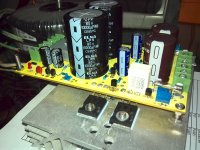
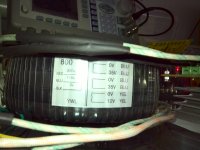
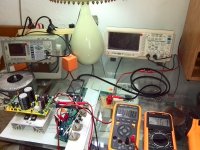

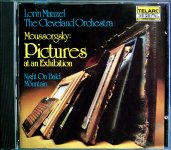
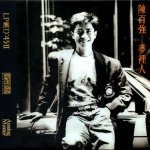
Jazz
 ,
,Just here to report the latest progress. Have just completed the JC2013 LDO psu for the amp. It is powered by a 800W 37Vx2 toroid, output voltage set to +/-46VDC. With this PSU, and take the time when the kid and her mother is out, the sound test is performed again at higher than usual listenning SPL with a fostex full range BLH speaker. Test CD/sound tracks are 1) The Planets by Gustav Theodore Holst from DG2530102 played by Boston Symphony Orchestra 2) Pictures at an exhibition by Modest Petrovich Moussorgsky from Telarc80296 3) Track No.1&9 by Danny Chan from Dream Lover EMI FX50013 4) You Go To My Head by Diana Krall from Verve UMG LG00383.
I should say that I enjoyed the sound from the speaker this time more than ever😀. If not for that the door bell rang🙁 in the middle of Diana's song, I would like to continue the play.
Two differences can be immediately identified, the background is much cleaner, and there are more fine details at the highs.
Before the listenning test, I re-adjusted the quescent, so that each output transistor had a bias around 210mA. By using a 50KHz sq. ware, I could see that the crossover closed seamless by increasing the current from aound 100mA to 210mA. I also performed the sine wave test. Then, the drawback becomes obvious. It can only output an un-clipped 34Vpp with 46VDC rail voltages, and the amp is running very hot. You cannot touch the sink for more than a split of a second😱. I read 84degree on my infra-red thermal meter aimed at the top the cans.






Jazz
Last edited:
Saying "balanced VAS", I don't mean complementary push-pull, I mean something like this. Fully symmetric, same signal path for both shoulders...
R8 may be a CCS. Bias is set by adjusting its current.
No, they are fine, just two resistors missing - from Q7, Q8 bases to the ground.
It was late and I was in a hurry 🙂
- Status
- Not open for further replies.
